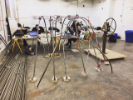Trellis at Silo City

Rendering of conceptual installation with full grown plantings.
Willow Way aims to create a space for observing time and growth of both the site and structure by using architecture as the infrastructure for habitat and landscape.
The organic structure is constantly growing and evolving, putting the growth of the willows on display. Over time, the willows will intertwine and graft together to become one organism. Nature will overcome the architecture, creating a habitat for both animals and people.
Gallery
Students
Sneha Arikapudi, Leticia Avila, Mark Bajorek, Vincent Bianco, Garth Burke, Leah Carpenter, Huaxiu Chen, Sonali Debas, Ben Ezquerra, Hope Forgus, Alejandro Frank, Bhalendu Gautam, Wade Georgi, Lizzy Gilman, Natalie Harack, Gwyn Harris, Lydia Ho, Lovepreet Kaur, Katie Lass, Heather Leslie, Mitchel Mesi, Christian Perrone, Forrest Rall, Brenna Reilly, Nathan Roukous, Yukta Satpute, Tom Schunk, Robert Sullivan, Christa Trautman, Debbie Urban, Chris Welch, Adara Zullo
Faculty
Laura Garofalo Khan, Joyce Hwang, Nicholas Rajkovich
Term
Environmental Practices studios completed Spring 2020
Program
MArch
As the soil at Silo City became polluted with slag from the site’s industrial activity, native plants had trouble surviving, and invasive species, such as Japanese Knotweed, began to take over. While these plants are beneficial in that they have begun to improve soil health through biomass and plant matter decay, they are aggressive and severely limit biodiversity. The specific location for the trellis was chosen because there is a large expanse of Knotweed in that area. The project aims to establish a system of remediation for the areas of monoculture on site by creating an infrastructure for habitat and growth.
The willow training process itself is quite simple. When planting the willows, they must be an adequate distance apart, about 8-10” in this case. Pruning any extra vertical branches maintains one central leader, and pruning the bottom third of the branches promotes vertical growth.
The form was derived from an initial desire to create a large open gathering space. As the willows wouldn’t grow long enough to reach the top of the dome, the center is grounded to allow them to grow from both the inside and outside. The structure is then pulled down to touch the ground in three places, keeping the center open. As such, the metal skeletal frame becomes the infrastructure through and on which the willows are woven.
The interior becomes a gathering space and an educational opportunity for earning about ecology and the current regenerative efforts. Community members can help train the willows and learn about composting systems.
This project began in Fall 2019, with a studio co-taught by former associate professor of architecture Laura Garofalo, in which students made proposals for a structure that would help eradicate invasive species at Silo City, and add to the natural and cultural regeneration happening in the industrial landscape.
The following semester, in the Spring of 2020, began with many iterations of testing in the workshop to experiment with fabrication and construction methods. This studio, taught by associate professor and associate chair of architecture Joyce Hwang, began with an offer from Rigidized Metals to donate excess Viper Tube pieces for a design-build installation. The tubing is not typically used for structure, leaving room for exploration on the best way to bend and connect the donated pieces.
One bending method was a manually operated Conduit Bender, which makes it difficult to achieve the accuracy of a digitally operated machine. When campus facilities were shut down due to the COVID-19 pandemic, the studio took what they had learned from their experimentation and applied those lessons to a new project of producing construction documents and detailed shop drawings that could be handed down to another studio once it was safe for students to gather outdoors to work on-site at Silo City.
In the Fall of 2020, a third studio, taught by assistant professor of architecture Nicholas Rajkovich, students began fabricating and assembling pieces on-site. To ensure everyone’s safety, students followed all UB health and safety guidelines, and worked in separate teams, alternating days at Silo City.
Now that the foundation and structure are in place, the next step is planting and training the willows. The construction story has been actively documented on the newnatures_buffalo Instagram feed, and has already been excitedly received by the public. As the trees begin to fill in the Viper Tube lattice, the structure will come to life.
The team extends a special thank you to all the volunteers who made the project possible: Randy Fernando, Paul Fuhrmann, Ross Holmes, Josh Kneer, Laura Lubniewski, Mike Paraszcak, Will Quintana, Tim Ray, Lindsay Romano, Nicole Sarmiento, Josh Smith, Rick Smith, and Shashi Varun.

Construction progress of the trellis project at Silo City in Buffalo, Fall 2020. Photo by Meredith Forrest Kulwicki
Read news coverage of our Ecological Practices graduate research studio and see photos from the Silo City worksite.





